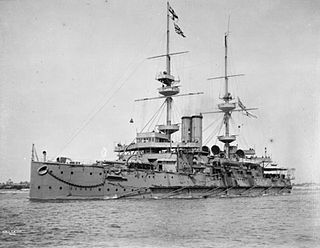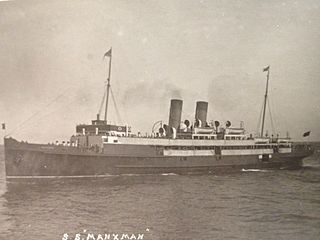
HMS Caesar was a Majestic-class pre-dreadnought battleship of the Royal Navy, named after the Roman military and political leader Julius Caesar. The ship was built at the Portsmouth Dockyard, starting with her keel laying in March 1895. She was launched in September 1896 and was commissioned into the fleet in January 1898. She was armed with a main battery of four 12-inch (305 mm) guns and a secondary battery of twelve 6-inch (152 mm) guns. The ship had a top speed of 16 knots.
Nine ships of the Royal Navy and one of the Royal Fleet Auxiliary have been named Argus, after Argus, the hundred-eyed giant of mythology:
The Wigham Richardson shipbuilding company was named after its founder, John Wigham Richardson (1837-1908), the son of Edward Richardson, a tanner from Newcastle upon Tyne, and Jane Wigham from Edinburgh.

The Isles of Scilly Steamship Company (ISSC) operates the principal shipping service from Penzance, in Cornwall, to the Isles of Scilly, located 28 miles (45 km) to the southwest. It provides a year-round cargo service together with a seasonal passenger service in summer. The name of the company's principal ferry, the Scillonian III, is perhaps better known than that of the company itself.

HMCS Lady Evelyn was a commissioned patrol boat of the Royal Canadian Navy during the First World War. Originally built as a passenger liner, Deerhound, she was acquired in 1907 by the Canadian government and renamed Lady Evelyn for use by the post office. After the war, she was sold for civilian service and scrapped in 1936.

HMS Montclare (F85) was a British ocean liner that was commissioned into the Royal Navy as an armed merchant cruiser in 1939, converted into a destroyer depot ship in 1944 and a submarine depot ship in 1946. She was decommissioned in 1954 and scrapped in 1958.
HMS Puttenham(M2784) was a Ham-class inshore minesweeper of the Royal Navy. She was launched in 1956 and entered service in 1958. The 93 ships of the Ham class had names chosen from villages ending in -ham. The minesweeper was named after Puttenham.
RMV Scillonian was a passenger ferry built for the Isles of Scilly Steamship Company in 1925 by the Ailsa Shipbuilding Company Ltd of Troon, Scotland. She was designed to carry 400 passengers and cargo between Penzance, Cornwall, UK, to the offshore Isles of Scilly.
The West Cornwall Steam Ship Company was established in 1870 to operate ferry services between Penzance, Cornwall, and the Isles of Scilly. It became the West Cornwall Steamship Company in 1907 and was wound up in 1917.

HMS Ramillies was a Royal Sovereign-class pre-dreadnought battleship of the Royal Navy, named after the Battle of Ramillies. The ship was built by J. & G. Thompson at Clydebank, starting with her keel laying in August 1890. She was launched in March 1892 and commissioned into the Mediterranean Fleet as flagship the following October. She was armed with a main battery of four 13.5-inch guns and a secondary battery of ten 6-inch guns. The ship had a top speed of 16.5 knots.

HMS Royal Oak was one of seven Royal Sovereign-class pre-dreadnought battleships built for the Royal Navy during the 1890s. Upon her completion in 1894, she was initially placed in reserve until mobilised in 1896 for service with the Flying Squadron. After returning briefly to reserve, the ship was assigned the following year to the Mediterranean Fleet. Royal Oak remained there until 1902 when she returned home; after a refit, the ship was assigned to the Home Fleet, where she served as the flagship of the fleet's second-in-command in 1904–05. Royal Oak was then reduced to reserve until she was taken out of service in 1911. The ship was sold for scrap in early 1914.

TSS Manxman was a turbine steamship launched in 1904 for the Midland Railway and operated between Heysham and Douglas, Isle of Man. In 1916, she was commissioned by the Royal Navy as HMS Manxman and saw action as a seaplane carrier during the First World War, after which she was acquired by the Isle of Man Steam Packet Company. On the outbreak of the Second World War she was again requisitioned as a troop ship, until she was commissioned and her name changed to HMS Caduceus. She never returned to Manx waters, and was scrapped in August 1949.

HMS Malabar was a Euphrates-class troopship launched in 1866, and the fifth ship of the Royal Navy to employ the name. She was designed to carry troops between the United Kingdom and British India, and was employed in that role for most of her life. She became the base ship at the Royal Naval Dockyard, Bermuda in 1897. She was renamed Terror in 1901 and sold in 1918. Her name was later used as the stone frigate to which shore personnel in Bermuda were enrolled, and later for Her Majesty's Naval Base Bermuda, after the 1950s, when the dockyard was reduced to a base.

HMAS Grantala was a passenger steamship that was built in England in 1903 as a coastal interstate liner for the Adelaide Steamship Company. In 1914 the Commonwealth government requisitioned her as a Royal Australian Navy hospital ship.
The Alderney Steam Packet Company provided shipping services between Alderney and Sark, Guernsey and Cherbourg from 1897 to 1931.

HMS Ambrose was a steamship that was built for in 1903 as a passenger liner. The Booth Steam Ship Company ran her scheduled on services between Liverpool and Brazil until the First World War.
HMS Rowley was a British Captain-class frigate of the Royal Navy in commission during World War II. Originally constructed as a United States Navy Buckley class destroyer escort, she served in the Royal Navy from 1943 to 1945.

HMS Vectis (D51) was a V-class destroyer of the British Royal Navy that saw service in World War I and the Russian Civil War.
SS Lady of the Isles was a passenger vessel built by Harvey and Company, Hayle for the West Cornwall Steam Ship Company in 1875.










